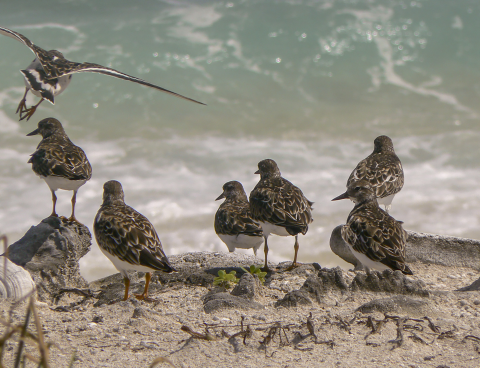Photo By/Credit
USFWS, Pacific Islands
Date Shot/Created
11/09/2021Media Usage Rights/License
Public Domain
Image
Howland Island National Wildlife Refuge, part of the Pacific Remote Islands Marine National Monument, was established in 1974 and lies just north of the equator in the central Pacific Ocean.
At Howland, nesting and foraging seabirds dominate the landscape while sheer isolation and solitude help us see our place in the natural world. Natural, physical, and ecological processes unfold with limited interference, and support a diverse community of native marine organisms, including seabirds, marine mammals, turtles, fish, plants, corals, and other invertebrates.
Howland Island is the crest of an ancient steep-sided coral reef cap and massive underlying extinct volcano emerging from the deep ocean floor of the equatorial Pacific. The equatorial undercurrent deflects off the western flank of the seamount, pushing nutrient-rich waters up into the sunlit zone, thereby increasing marine productivity and benefiting many species of marine life. This important phenomenon may be limited only to Howland, Baker, Jarvis Islands, and a few other islands in the Pacific because of their steepness and location on the equator.
The Pacific Remote Islands National Marine Monument is one of the largest marine conservation areas in the world and protects over 400,000 square miles and seven national wildlife refuges on coral islands, reefs, and atolls.
At Howland, nesting and foraging seabirds dominate the landscape while sheer isolation and solitude help us see our place in the natural world. Natural, physical, and ecological processes unfold with limited interference, and support a diverse community of native marine organisms, including seabirds, marine mammals, turtles, fish, plants, corals, and other invertebrates.
Howland Island is the crest of an ancient steep-sided coral reef cap and massive underlying extinct volcano emerging from the deep ocean floor of the equatorial Pacific. The equatorial undercurrent deflects off the western flank of the seamount, pushing nutrient-rich waters up into the sunlit zone, thereby increasing marine productivity and benefiting many species of marine life. This important phenomenon may be limited only to Howland, Baker, Jarvis Islands, and a few other islands in the Pacific because of their steepness and location on the equator.
The Pacific Remote Islands National Marine Monument is one of the largest marine conservation areas in the world and protects over 400,000 square miles and seven national wildlife refuges on coral islands, reefs, and atolls.
